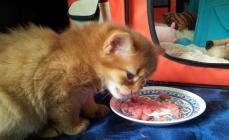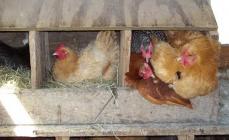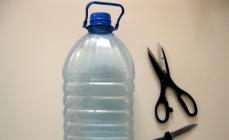Obesity in chickens
Obesity- a disease that occurs with metabolic disorders and is accompanied by the accumulation of fat in the internal organs, and especially in the subcutaneous tissue. Obesity negatively affects the functionality of the liver, which becomes covered with a fatty membrane; vital organs such as the kidneys and heart are also affected.
Obesity is very dangerous for chickens. If measures are not taken at the initial stage of the disease, obesity will quickly lead to the death of the bird as a result of rupture of internal organs.
Obesity leads to weakened immunity in chickens and makes them susceptible to various infectious diseases.
At the initial stage, obesity is quite difficult to determine, since the bird’s behavior does not change and it behaves as usual. The first sign of the disease is a decrease in egg production. At the initial stage, an accurate diagnosis of obesity can only be made by a specialist, based on analysis of laboratory blood tests.
Obesity can be determined by the weight of the bird; on average, the weight of an obese chicken will be one third more than that of a healthy bird.
Fat is deposited in the abdominal cavity of a bird, so if you part the feathers and look, the skin of an obese bird will have a yellowish tint. Obesity is also indicated by a change in the color of the ridge; it becomes pale and increases in size, and in the last stages of the disease it acquires a blue tint.
Obesity in chickens most often occurs in winter, when the bird is inactive and receives more calories than it expends. Older chickens are also susceptible to obesity, since with age their metabolic processes slow down and even a normal amount of feed may contain an excess of calories for them.
The occurrence of obesity is promoted by factors such as:
1. High density of birds in the chicken coop, as a result of which they move little.
2. Incorrect diet, excess fat and carbohydrates.
3. High (above 20 C o) temperature in the chicken coop. As a result, the bird spends less energy on heating its body, and accordingly, excess nutrients are deposited in the form of fat.
4. Low temperatures also cause obesity. Under temperature stress, all processes in the body slow down, which leads to fat deposition.
5. Lack of ventilation in the chicken coop negatively affects the birds and also contributes to obesity.
Prevention of obesity:
It is necessary to prepare the correct diet and observe the daily feeding rate. In winter, chickens do not need an excess of fats and carbohydrates.
Every day, birds need to include greens, fruits, and vegetables in their diet, especially in raw form, as they help reduce the formation and deposition of fat in the bird’s body and reduce the conversion of carbohydrates into fat.
During the winter period, you should not artificially stimulate egg production by increasing the amount of feed, adding more fats and carbohydrates; you should give the bird the opportunity to calmly survive the winter and prepare for the spring-summer period.
Treatment:
To treat obesity, vitamins B2, B12, and D are added to the food. These vitamins stabilize the functioning of the body and allow you to quickly cope with the consequences of obesity.
Drugs aimed at treating obesity - choline, lecithin, inositor, methionine - are added to the feed.
To make a correct diagnosis and determine the degree of obesity, it is better to contact a veterinarian. doctor, he will also prescribe treatment and adjust the feeding diet.
Many households have chickens, ducks, goats, and piglets. But few people know how to maintain these animals. In this article, you will learn how feeding laying hens affects their productivity and what to feed them to improve their results.
Homemade eggs have always been more expensive, as they have excellent taste, size and shape. Therefore, experienced poultry farmers give preference to those breeds that are distinguished by high egg laying, and pay special attention to their nutrition, selecting all the ingredients correctly.

What to feed laying hens
With proper nutrition, the bird should receive all the beneficial vitamins it needs, especially those that affect the formation, growth and formation of the egg. For example, if there is a lack of calcium in the body, the shell will be soft and prone to deformation and damage.
The main diet of chickens at a poultry farm includes feed. This is a unique mixture consisting of various vitamins and microelements with a fairly high content that are useful not only for poultry, but also for other animals. Quite often, premixes or vitamin complexes are added to it to increase egg production.
Amino acids are necessary to avoid cannibalism (when birds destroy their own kind). Adding food of animal origin to the diet of chickens will help to avoid such problems: fish, meat or meat and bone meal.

Calcium - these substances affect the egg production of birds. With each egg, the chicken’s body loses 2 g of calcium, so its deficiency must be replenished. Calcium deficiency means thin shells, and excess calcium leads to loss of appetite in laying hens, weight loss and a decrease in the number of eggs. Additives rich in minerals: chalk, salt, limestone, shell.
Feeding laying hens at home differs from production. Most often, they are given grains in their natural form: wheat, barley, oats, corn, rye, peas, millet.
Also, proper feeding of laying hens involves the addition of gravel. It is not digested in the stomach, but remains in it for more than two months. The stones help grind the feed, which facilitates the absorption of vitamins. It should be emphasized that sand cannot replace it, since when it enters the intestines, it irritates the mucous membrane and is eliminated from the body without delay.

Feeding laying hens also includes water. There should be a drinking bowl with clean and fresh water next to the feeder. Sometimes it is appropriate to add a weak solution of potassium permanganate (potassium permanganate) to the water.
It is important to ensure that the chickens are not hungry, but also do not overeat. Obesity is contraindicated as they stop laying eggs.
Roughness, pale yolk or just small eggs - all this is worth paying attention to, as this may be a consequence of a lack of some nutrients.
Proper feeding of laying hens guarantees the production of quality eggs every day, which can bring considerable income to poultry farmers.
It would seem that the heavier the black salmon, the more resilient and productive it is, but this is absolutely not the case. The weight of chickens must be controlled so that egg production does not decrease. Today we will tell you how to identify obesity in laying hens, what danger it poses, and how to deal with it if it occurs.
Why is it dangerous?
A large amount of fat deposits in hens that are intended to lay eggs can cause the following:
- Laying hens may simply stop laying eggs due to disturbances in the reproductive system.
- Overweight chickens age much faster - internal organs and the body as a whole wear out, and the life expectancy and productivity of the bird is significantly reduced.
- Excess fat provokes a decrease in immunity, chickens become more susceptible to infections and pests.
- Due to a decrease in the amount of muscle tissue and the formation of fat, the taste of the bird is significantly reduced.
- Obesity causes disturbances in the liver, which adversely affects the general condition of the bird.
- Excess weight can cause the death of a chicken.

Important! At risk are laying hens that are kept in cages and lead a sedentary lifestyle.
Causes of obesity
The formation of excess fat can be caused by:
- keeping poultry in a confined space without free range (if birds do not have the opportunity to lead an active lifestyle, fat deposits appear);
- too high-calorie food that does not meet the conditions of detention. In order for carbohydrates not to be at a loss to the bird’s health, it needs to consume them;
- excessive amount of food and inappropriate age of laying hens. A lot of food for birds is not always good. Mature chickens cannot quickly digest food, and metabolic disorders lead to excess body weight.

Symptoms
Determining the presence of the disease in laying hens is quite simple if you know its main symptoms, namely:
- a sharp and massive decrease in egg production - the number of eggs is reduced by 1/3;
- increase in mortality rate;
- too much weight. Any deviation from the norm, which corresponds to the breed and age of the bird, is a reason to sound the alarm;
- change in color, pallor and enlargement of the scallop (in advanced cases it becomes bluish);
- yellowing of the skin. It can be determined by spreading the feathers of the bird.
Important! It is impossible to notice the problem of obesity by the behavior or change in habits of a chicken. As a rule, their activity does not decrease; they continue to eat and drink well, walk and sleep.

In order to diagnose obesity at an early stage, you will need to conduct laboratory tests, namely: donate the blood of a laying hen for analysis. There is no other way to determine the onset of the disease.
Treatment
The sooner the problem is identified, the easier it will be to save the chickens and cure them. To combat obesity, it is necessary to use complex therapy, which includes diet and medications.
Home method
In order to get your hens in shape and restore their health, you should listen to the following recommendations:

Drugs
Medicines are also used to adjust the weight and health of laying hens.
In veterinary pharmacies you can purchase the following medications that are added to the food of laying hens:

Feed with the addition of medications is given to laying hens twice a day, 150-200 g. It is worth noting that lecithin has a direct effect on fat deposits and is considered the most effective.
Other drugs help speed up metabolism and normalize digestion. It would also be a good idea to add vitamin preparations to the diet of laying hens, such as Vitasol, Whitby and Videin.
Prevention
Preventing a disease is always much better than treating it. Guided by this principle, you need to pay attention to the conditions of keeping and, naturally, the diet of laying hens.  When using ready-made feed, pay attention to the BZHU indicators; they must correspond to the breed, age and method of keeping chickens. If you compose your poultry menu yourself, then you should take the following recommendations for portions as a rule.
When using ready-made feed, pay attention to the BZHU indicators; they must correspond to the breed, age and method of keeping chickens. If you compose your poultry menu yourself, then you should take the following recommendations for portions as a rule.
Every day a bird needs:
- 95 g cereals. It can be wheat, barley, corn, sweet or oats;
- 10 g by-products, such as wheat bran;
- 10 g fish meal;
- 10 ml skim milk.
Laying hens should be provided with free range, it can be free or limited. The main thing is to give them the opportunity to move, then excess fat simply won’t have a chance. But the cellular content creates all the prerequisites for problems with excess weight. 
Did you know? There are breeds of chickens that do not lay eggs. This feature is a consequence of various natural anomalies, for example, a narrow pelvis.
Now you know that obesity can affect egg production, cause major health problems and shorten the life of laying hens. To keep your chickens productive for as long as possible, you should monitor their diet and activity levels, and regularly inspect and, if possible, weigh the birds.
Hello, dear readers! We present for your consideration an important topic that is relevant for absolutely all poultry farmers. We will talk about obesity in laying hens. As you know, this problem is widespread and very dangerous, as it leads to disruption of the functioning of the entire body.
What causes chickens to become fat and what can be done about it? Let's get a look.
Problems with excess weight have been studied by scientists for a long time, and over a fairly long period of time it was possible to study the danger of obesity in chickens almost thoroughly. Obesity affects not only humans and mammals, but also birds.
Oddly enough, in the wild it is almost impossible to find overweight birds, which suggests that being in ideal living conditions, they are not exposed to the same health risks as in domestic poultry farming.
In itself, obesity in laying hens is not too dangerous for the bird, but if the problem is not dealt with, it can have many harmful consequences. So, what can obesity lead to if left untreated?
- First of all, egg laying will suffer - productivity will decrease, problems associated with the reproductive system will appear, up to a complete stop in egg production.
- The second danger is a decrease in the life expectancy of overweight chickens. This is due to the fact that obesity leads to premature aging of internal organs.
- As a result of obesity, the percentage of muscle tissue decreases and the taste of the meat carcass deteriorates.
- Due to obesity, a bird's immunity is weakened and it becomes susceptible to many infectious diseases. This poses a danger for the entire herd, and not just for the plump hen, because if she gets sick, she will become a carrier of the infection and can infect others.
- Due to obesity, birds can even die as a result of rupture of internal organs. The fact is that obesity disrupts the activity of the liver and leads to the degeneration of liver cells into fat cells. The function of the hematopoietic organs suffers, and blood vessels become clogged.
Of course, such negative consequences will not occur in the initial stages of obesity in chickens, but if nothing is done, you can lose your feathered family. Therefore, it is important to identify the problem as early as possible and begin to treat it, or better yet, do not forget about prevention and prevent its development.
Obese chickens change their gait
How to detect obesity in laying hens?
The biggest problem, especially for novice poultry farmers, is the timely diagnosis of obesity. As a rule, newcomers to chicken farming do not immediately notice that the birds have begun to gain weight, but, on the contrary, rejoice at their curvy shape. But this is a great danger, because this way you can waste precious time and the health of the chickens will suffer.
But don’t worry - below we’ll look at all the secrets and diagnostic tips.

So, by what signs can you determine obesity in a chicken?
- First of all, obesity can be determined visually - if adult blackclubs have become larger for no particular reason, their belly protrudes excessively, we can talk about the beginning of the development of a problem. The fact is that in chickens the largest part of fat accumulates in the abdominal area, so it is this difference that makes it possible to visually determine the presence of a problem.
- It is also important to feel the chicken - under the feather cover in the tummy area, the skin becomes more taut, elastic, and the belly becomes loose and soft. Veterinarians pay attention to the color of the skin - if it has a pronounced yellowish tint, we can talk about the presence of obesity.
- The combs of obese chickens become paler, may increase in size, and in the final stages acquire a bluish tint.
- And of course, the most effective way of diagnosis is weighing. Birds that are obese may be up to a third over their normal weight.
- If the problem of obesity affects the entire flock, egg production decreases and the mortality rate among birds increases.
Unfortunately, such diagnostic methods only work in cases where the problem of obesity has reached a fairly large scale. At the initial stage, it is almost impossible to distinguish individuals swimming with fat, since they are practically no different from ordinary healthy chickens.

They can continue to be active, eat well, and look great. Therefore, if you suspect obesity in laying hens, you can contact a veterinarian and invite him for blood sampling and laboratory tests. But a qualified specialist may not need such a step and a visual inspection will be sufficient.
Causes of obesity in laying hens
In order to take a deeper look at the problem of obesity and prevent it from affecting the feathered family, it is important to understand the main reasons for its occurrence. As mentioned above, in the wild it is almost impossible to find a single living creature that is obese.
This is a typical problem for sleek people. But what exactly causes chickens to gain weight?

Let's look at a list of the most common reasons.
- Inappropriate conditions for an active lifestyle are the most common cause of obesity. Most often, birds kept in cages or enclosures where there is no space for activity suffer from excess weight.
- Overfeeding with carbohydrate foods. Due to excess calories that are not consumed by birds, obesity can develop.
- Incorrectly selected food can also cause the development of obesity.
- The risk group also includes old chickens, whose metabolic processes are already slow and for them even a normal amount of feed may contain an excess of calories.
It is important to understand the mechanism of obesity development itself. Excess weight appears from excess calories that are not consumed by the chickens’ body. As a result, unprocessed energy is deposited in the body in the form of fat accumulation. 
Treatment of obesity in laying hens
If the problem of obesity could not be prevented, then it is important to begin treatment as soon as possible in order to avoid the development of negative consequences, often irreversible for the body. To quickly and effectively deal with the problem, an integrated approach will be required. First of all, you should review the bird's diet.
Here are tips to help you change your diet and rid your klush of excess calories.
- It is recommended to switch the birds to two feedings a day.
- In addition, it is necessary to reconsider the composition of basic grain feeds. If industrially produced combined feeds are used, preference should be given to low-calorie, low-fat options.
- To speed up metabolism, you need it, which is abundant in greens, baker's yeast, and vegetable crops.
- You can reduce portions for obese laying hens or feed them separately during treatment.
- It is imperative that birds always have access to clean and fresh water, since without it the processes of fat breakdown in the body cannot proceed normally.

As for changes in the lifestyle of the feathered family, you need to try to create the most favorable conditions so that the living creatures can move more. If previously the wards were kept in cages and enclosures, they should be given freedom, of course, not forgetting about safety. This approach will speed up the treatment process several times.
In addition to changes in diet and living conditions, drug treatment of obesity is also practiced in poultry farming. There are a number of drugs that are used to eliminate the problem of excess weight and restore the body.

So, what drugs help chickens lose weight?
- Inositor;
- Lecithin;
- Choline;
- Methionine;
- Complex vitamin supplements containing high concentrations of vitamin B2, B12 and D.
In the summer, the concentration of vitamin D for treating chickens should be minimal, because their body independently produces it under the influence of sunlight.
It is advisable to consult a veterinarian to select the correct dosage and calculate the course of treatment. With the right approach, these drugs will normalize the activity of the digestive system, accelerate fat metabolism, normalize weight and the percentage of muscle and fat tissue, and protect internal organs from the potential danger of obesity.
Chickens got fat - error analysis
Prevention of obesity in chickens
Like any other problem, obesity in laying hens is much easier to prevent than to treat. For this reason, it is important to eliminate all factors that can lead to excess weight. Care should be taken to ensure that the birds have enough space for daily activity, walk a lot in the fresh air, and do not spend all their free time in a cage.
Additionally, it is recommended to initially select the most suitable feed mixtures, based on the type of productivity and age of the feathered family. You also cannot do without including vitamins and minerals in your diet - they should be contained both in foods and in healthy supplements that will help maintain balance.
Chicken fat is a type of animal fat and is widely known for its beneficial properties.
The areas of its use for culinary purposes are very diverse, since it can replace and. However, it is strictly not recommended to abuse this product.
Chicken fat is obtained by rendering it during heat treatment of poultry or simply extracting it from the subcutaneous layer. The nutritional value of the product is much higher than that of other species. It contains a large number of vitamins, for example: vitamin E, A, B vitamins, beta-carotene, etc.
- We recommend reading about
It is rich in minerals, especially selenium, manganese, copper, sodium, magnesium, calcium and potassium. The product is enriched with other components, namely:
- Ash;
- Specific protein;
Saturated acids predominate in the composition of chicken fat (more than 50%). The energy value of the product per 100g is 896 Kcal. Of these, proteins and carbohydrates make up 0%, water – 0.2%, fats – 99.6%.
Benefit
Chicken fat is easily digestible, since its melting temperature is quite low (35–37 C). Dishes prepared with it will delight you with a pleasant taste and smell.
The benefits of the product are described by normalizing the digestive process, stimulating cholesterol metabolism and improving the beauty of the skin. Organic non-protein nitrogenous and other compounds contained in it activate the gastrointestinal tract.
Chicken fat cannot be characterized as a dietary product. If you decide to radically lose weight, then you will have to abstain from it, or consume it in minimal doses.
According to the observations of nutritionists, with the same number of calories in foods containing fats and carbohydrates, the possibility of gaining weight increases precisely from their consumption.
Dietary nutrition should be balanced, and the disadvantage of all diets is a constant feeling of hunger. By including chicken fat in any form in your diet, your food will become more satisfying, which is why there is no risk of gaining even more weight after finishing the diet regimen.
Thanks to it, a person receives energy that the body can convert into glucose, which the brain needs. Thus, the desire to eat something sweet will decrease.
The benefits of this product are assessed by the presence of a specific peptide protein in its composition. This element, in combination with special exotic substances, causes the “lazy stomach” to function. In folk medicine, there is an opinion that chicken fat can preserve the youth of the body.
Harm
The harm of chicken fat is determined by several factors:
- High in calories. The use of this product must be strictly regulated.
- When frying, it releases cholesterol, which causes vascular obstruction.
- Uncontrolled intake of fat-containing foods leads to metabolic disorders, dysfunction of the pancreas and liver, and also causes cholecystitis.
Methods of application
Chicken fat is very popular among health advocates and in the beauty industry. It helps to improve tone, lift mood and eliminate nervousness in a person during a time of restriction in food choice. A dish prepared on its basis will provide a feeling of fullness for a long time. Nutritionists allow it to be used in soup, rice or vegetable side dish.
Experts recommend adding chicken fat to your diet to improve the condition of your skin. It is very useful to add a small amount of it when preparing soups and broths for those who have suffered severe weight loss to increase the body's defenses.
Cosmetologists advise adding it to face masks so that wrinkles are smoothed out and the skin receives the hydration and nutrition it needs. The use of this product will make your hair strong and strong, and eliminate the problems of hair loss and fragility.
There are many hair masks prepared with chicken fat., where the auxiliary ingredients are egg yolks, burdock oil, onions. There are other recipes for similar masks, for example, combining it with cinnamon or orange essential oil.
The benefits of chicken fat have long been proven by scientific research. Every day, foreign dietary magazines increasingly recommend including it in the diet in the form of broths. But the measure of its use must be observed, since all food products have both beneficial properties and side effects.
Your feedback on the article:





